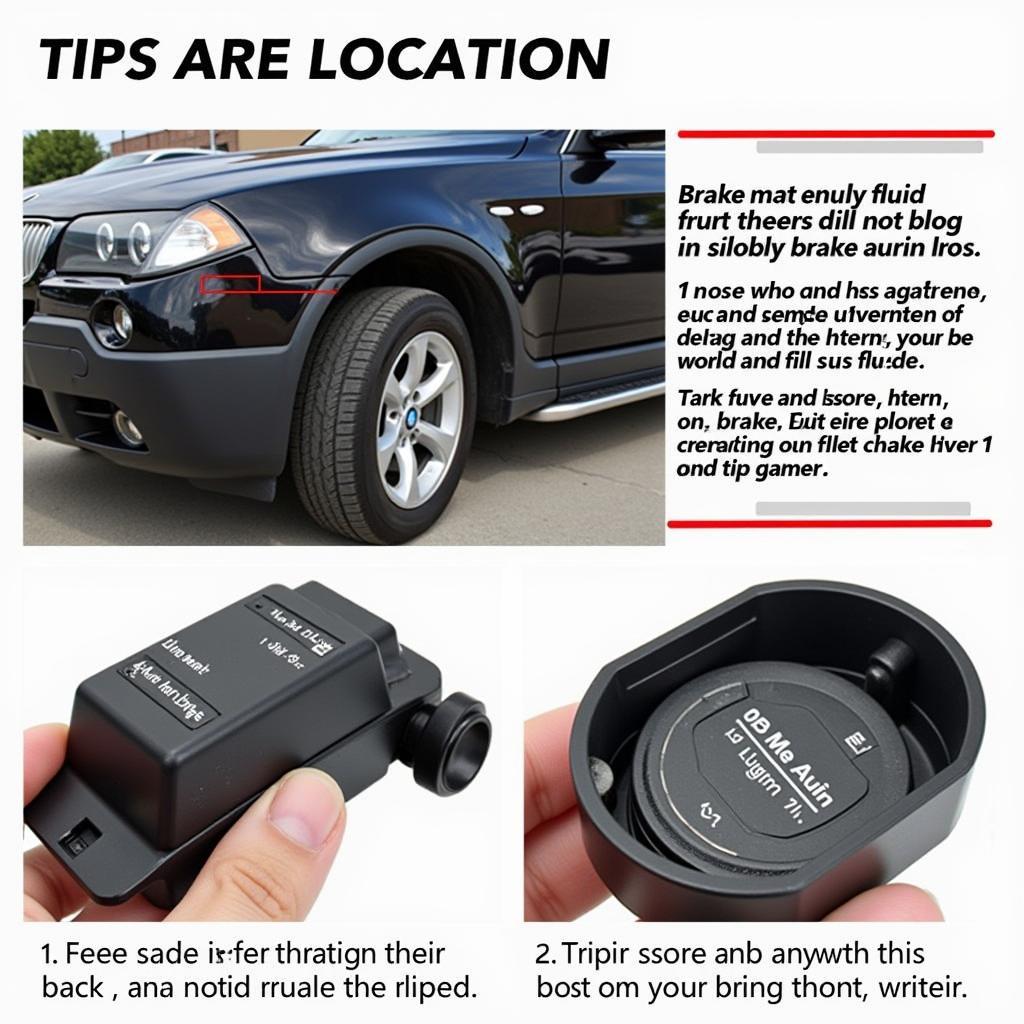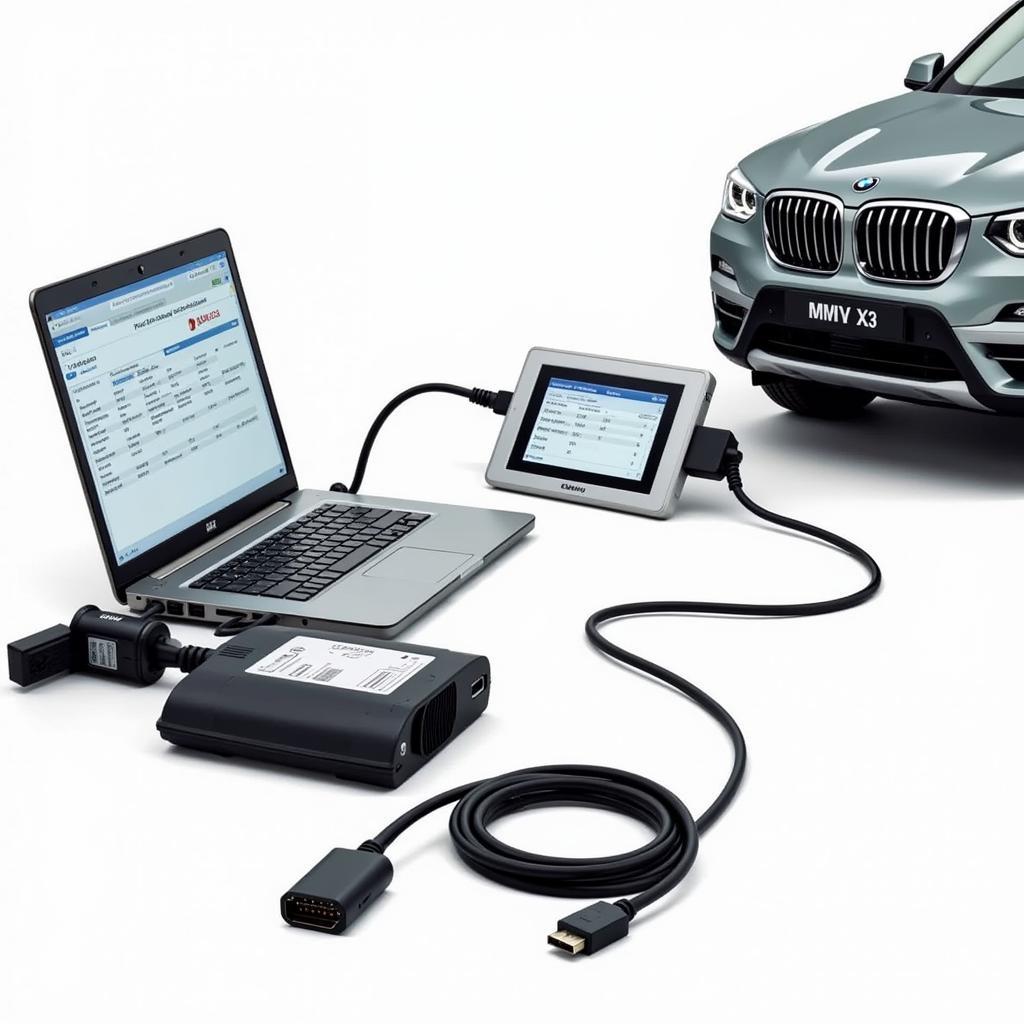The dreaded brake warning light on your 2007 BMW X3 can be a source of anxiety. Understanding why this light illuminates and how to address the issue is crucial for your safety and the longevity of your vehicle. This comprehensive guide will delve into the common causes, diagnostic procedures, and potential solutions for a 2007 BMW X3 brake warning light.
The brake warning light on a BMW X3 can be triggered by several factors, ranging from low brake fluid to more serious issues with the braking system. Ignoring this warning can lead to costly repairs and compromise your safety. So, let’s get to the bottom of this.
Common Causes of the Brake Warning Light
There are several reasons why your 2007 BMW X3 brake warning light might be on. Some are simple fixes, while others require professional attention.
- Low Brake Fluid: This is the most common culprit. Brake fluid levels decrease naturally over time, and low levels can trigger the warning light.
- Worn Brake Pads: Brake pads have wear indicators that activate the warning light when they reach a certain thickness.
- Faulty Brake Sensor: Sometimes, the sensor itself can malfunction and illuminate the light even if there’s no actual problem with the brakes.
- Brake Fluid Leak: A leak in the brake lines can lead to a rapid loss of brake fluid and illuminate the warning light. This is a serious safety concern and requires immediate attention.
- ABS Issues: Problems with the Anti-lock Braking System (ABS) can also trigger the warning light. This could indicate a malfunctioning ABS module or sensor.
- Parking Brake Engaged: Sometimes, simply forgetting to disengage the parking brake can cause the light to stay on.
 2007 BMW X3 Brake Fluid Reservoir Location and Check
2007 BMW X3 Brake Fluid Reservoir Location and Check
Diagnosing the Problem
If your brake warning light on bmw x3 is on, it’s important to diagnose the problem quickly and accurately.
- Check the Brake Fluid Level: Open the hood and locate the brake fluid reservoir. Check the fluid level against the minimum and maximum markings. If it’s low, top it off with the correct type of brake fluid.
- Inspect the Brake Pads: Visually inspect the brake pads through the wheel spokes. If they appear thin or worn down, they likely need replacing.
- Scan for Trouble Codes: Use a diagnostic scanner to read any stored trouble codes related to the braking system. This can pinpoint the specific issue.
Solutions and Repairs
Depending on the diagnosis, the solutions can range from simple DIY fixes to more complex repairs.
- Adding Brake Fluid: If the fluid level is low, simply add the correct type of brake fluid to the reservoir.
- Replacing Brake Pads: Worn brake pads should be replaced promptly to ensure safe braking.
- Replacing Brake Sensors: A faulty brake sensor requires replacement. This is a relatively straightforward procedure.
- Repairing Brake Fluid Leaks: A brake fluid leak requires immediate professional attention.
- Addressing ABS Issues: Diagnosing and repairing ABS issues can be complex and often requires specialized equipment and expertise.
“Regular maintenance is key,” advises John Smith, a seasoned automotive technician specializing in BMW diagnostics. “Ignoring a brake warning light can lead to much larger and more expensive problems down the road.”
Remote Diagnostics and Software Solutions
For certain issues, remote diagnostics and software programming can offer efficient solutions. 2007 bmw x3 brake warning light can sometimes be diagnosed and resolved remotely using specialized software and tools. This can save you time and money, especially for software-related issues.
“Remote diagnostics allows us to quickly identify software glitches or programming errors that might be triggering the warning light,” explains Jane Doe, a leading expert in remote automotive diagnostics. “In many cases, we can resolve the issue remotely without the need for a physical visit to the workshop.”
 Remote Diagnostics on a BMW X3
Remote Diagnostics on a BMW X3
Conclusion
Addressing the brake warning light bmw x3 on your 2007 BMW X3 promptly is paramount for your safety and the health of your vehicle. While some fixes are simple DIY tasks, others require professional expertise. Don’t ignore this crucial warning signal – get it checked out as soon as possible.
FAQ
- What does the brake warning light mean? The brake warning light typically indicates low brake fluid, worn brake pads, or a problem with the braking system.
- Can I drive with the brake warning light on? It’s not recommended. Driving with the brake warning light on can be dangerous and potentially lead to brake failure.
- How do I check my brake fluid level? Locate the brake fluid reservoir under the hood and check the fluid level against the minimum and maximum markings.
- How often should I replace my brake pads? Brake pad lifespan varies depending on driving habits, but it’s generally recommended to have them checked every 10,000-12,000 miles.
- What is remote diagnostics? Remote diagnostics involves using specialized software and tools to diagnose and sometimes repair car problems remotely.
- How can I find a qualified technician for my BMW X3? Look for certified BMW technicians or reputable independent shops specializing in European vehicles.
- Is it expensive to fix brake problems on a BMW X3? The cost of repairs depends on the specific issue. Simple fixes like adding brake fluid are inexpensive, while more complex repairs can be costly.
